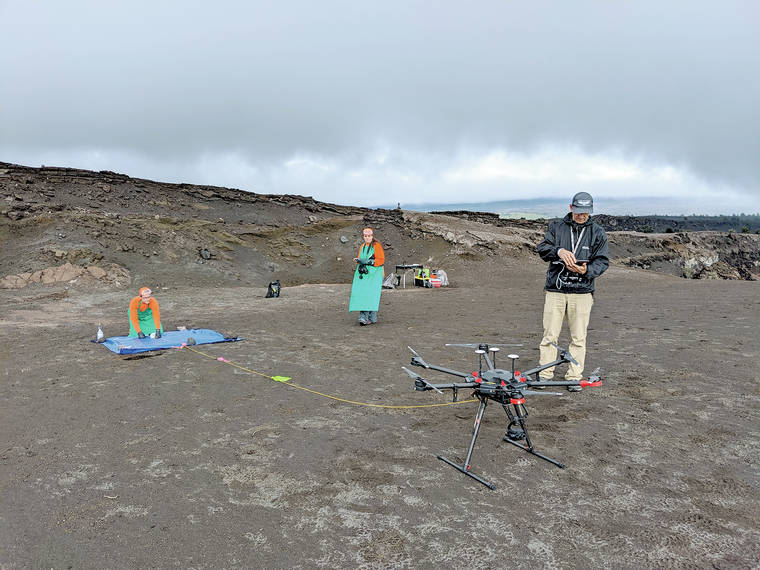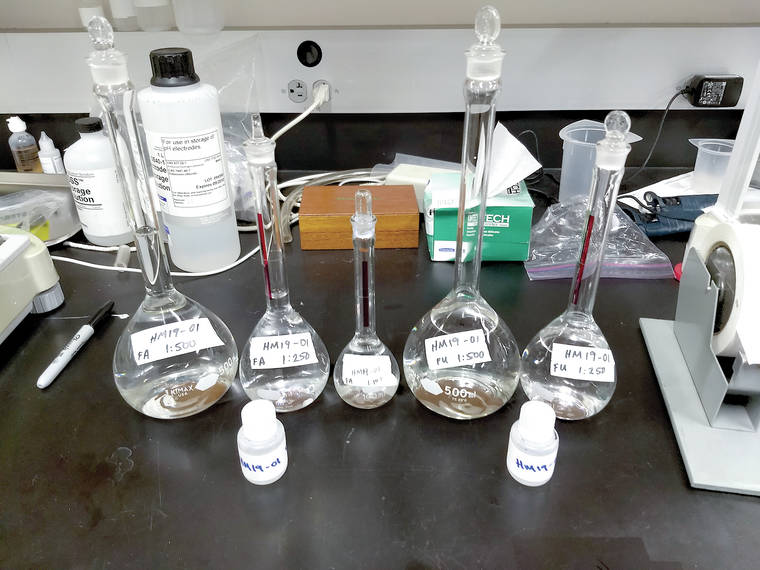Volcano Watch: Pondering the pond — what Halema‘uma‘u water chemistry tells us

J. ADAMS/DOI-OAS photo USGS Hawaiian Volcano Observatory and DOI Office of Aviation staff prepare the sampling mechanism (on blue tarp) and inspect the unmanned aircraft system (UAS) just before it took off to collect water from the Halema‘uma‘u crater lake. Brightly-colored flagging tape tied to a cable attached to the UAS indicated depth as the sampling tool was lowered into the water. The Oct. 26 UAS water collection flight was conducted with permission from and in coordination with Hawaii Volcanoes National Park.

S. PEEK/USGS photo, October 2019 Water collected from the lake at the bottom of Halema‘uma‘u is prepared for laboratory analyses at the USGS California Volcano Observatory. Results thus far reveal chemistry indicative of complex reactions between the water, magmatic gases and Kilauea’s basaltic rocks.
In the tradition of Hawaiian Volcano Observatory founder Thomas Jaggars innovative field methods, HVO recently used a cutting-edge technique to sample the Halemaumau water lake deep within Kilaueas collapsed summit crater.
In the tradition of Hawaiian Volcano Observatory founder Thomas Jaggar’s innovative field methods, HVO recently used a cutting-edge technique to sample the Halema‘uma‘u water lake deep within Kilauea’s collapsed summit crater.
Crater lakes occur in many volcanoes around the world, including Poas (Costa Rica), Kawah Ijen (Indonesia) and Whakaari/White Island (New Zealand). But water in Halema‘uma‘u is a first in written history for Kilauea, spurring interest locally and globally.
ADVERTISING
The water has risen about 1 meter (1 yard) per week since first spotted July 25. Initially, HVO was limited to remote observations of lake size, color and surface temperature.
As the lake grew, HVO began formulating a plan to sample the water. The lake’s chemistry could reveal where the water was coming from and what it might mean for degassing and potential hazards at Kilauea’s summit.
After much discussion, HVO and other USGS scientists, Hawaii Volcanoes National Park staff and helicopter and unmanned or unoccupied aircraft systems (UAS) pilots decided that a UAS was the best option for sampling and would be attempted.
Our opportunity came just after the lake’s three-month anniversary on Oct. 26, when a USGS UAS successfully collected about 750 milliliters (25 ounces) of water from the lake. The sample was then shipped to mainland USGS laboratories for sophisticated analyses.
Results thus far indicate an acidic lake, with a pH of 4.2 (neutral is pH 7). Interestingly, most volcanic crater lakes have a pH of less than 3.5 (more acidic) or higher than 5 (less acidic), which places the Halema‘uma‘u lake’s pH squarely in the uncommon middle range. However, that might result from the lake’s young age and ongoing growth.
Mathematical modeling performed prior to the lake’s appearance predicted that groundwater could flow into Halema‘uma‘u once the area cooled enough after the 2008-18 lava lake drained away.
So it was not entirely a surprise when water began to pond in the crater.
But it’s important to note that Halema‘uma‘u is where most summit sulfur dioxide (SO2) degassing takes place, and that SO2 dissolves readily in water.
As water flows underground toward the now-cooling crater, it dissolves SO2 rising from magma below. This leads to high concentrations of sulfate ions in the lake (53,000 milligrams per liter) and a tendency toward a more acidic pH.
However, that acidic water reacts chemically with Kilauea’s basaltic rock, which makes the lake less acidic (raises the pH) and results in high concentrations of magnesium in the water. (Basalt is classified as a mafic rock because of its large amount of magnesium and iron in addition to other elements such as sodium and potassium.)
The ratios of magnesium to sodium and sodium to potassium in the lake water are similar to those ratios in Kilauea’s basalt, which is further evidence of chemical reactions between the water and rocks.
Calcium concentrations are not very high in the water sample; calcium is instead combining with sulfate ions to form solid minerals that precipitate from the water. Iron is also likely forming various minerals, contributing to the lake’s yellowish colors.
Complex gas/rock reactions result in Kilauea’s lake water being chemically different from groundwater in a research well south of Halema‘uma‘u and from rainwater. Testing of oxygen and hydrogen that form the water molecules indicates the lake water was originally rain that percolated into the subsurface where it became groundwater and the chemistry changed.
The Halema‘uma‘u lake is still rising.
The current pH reflects the balance between incoming groundwater and the degree of SO2 degassing from below. If the lake level stabilizes, or the amount of SO2 changes, the pH could also change.
At Mount Pinatubo in the Philippines, after its cataclysmic 1991 eruption, a crater lake formed with a nearly-neutral pH but became more acidic with increased SO2 degassing and later volcanic activity.
Chemical analyses confirm that the Halema‘uma‘u crater lake dissolves magmatic SO2. This implies that HVO’s measured SO2 emission rates (about 30 tonnes per day) underestimate the total outgassed SO2 at Kilauea. Without the lake, SO2 emissions from the summit would likely be higher.
This finding is important given that an increasing SO2 emission rate can indicate shallowing magma. Now, lake sulfate concentrations might be a new clue to changing conditions at Kilauea.
Accordingly, we hope this first water sample is not our last.
Volcano activity updates
Kilauea Volcano is not erupting and its USGS Volcano Alert level remains at Normal (https://volcanoes.usgs.gov/vhp/about_alerts.html). Updates for Kilauea are now issued monthly.
Kilauea monitoring data have shown no significant changes during the past week. Rates of earthquake activity or seismicity across the volcano remain largely steady. Sulfur dioxide emission rates are low at the summit and below detection limits at Pu‘u ‘O‘o and the lower East Rift Zone. The water pond at the bottom of Halema‘uma‘u continues to slowly expand and deepen.
Mauna Loa is not erupting. Its USGS Volcano Alert level remains at Advisory. This alert level does not mean an eruption is imminent or progression to an eruption is certain.
During the past week, about 180 small-magnitude earthquakes (nearly all smaller than M2.0) were detected beneath the upper elevations of Mauna Loa. Deformation measurements show continued summit inflation, consistent with magma supply to the volcano’s shallow storage system. Fumarole temperature and gas concentrations on the Southwest Rift Zone remain stable.
Mauna Loa updates are issued weekly. For more information about the status of the volcano, go to https://volcanoes.usgs.gov/volcanoes/mauna_loa/status.html.
Ten earthquakes with three or more felt reports occurred in Hawaii this past week: six quakes with magnitudes between 1.2 and 4.9 generally located 26 km (16 mi) west of Pepe‘ekeo and at 30 km (19 mi) depth between 5:24 and 8:34 a.m. Nov. 11; two quakes with magnitudes 1.2 and 2.7 located 24-28 km (15-17 mi) east of Honaunau-Napo‘opo‘o at shallow depths at 6:09 and 1:39 a.m. Nov. 9; a magnitude-3.4 quake 10 km (6 mi) north of Waimea at 23 km (14 mi) depth at 5:48 a.m. Nov. 9 at 5:48 a.m.; and a magnitude-2.8 quake 4 km (2 mi) southeast of Honaunau-Napo‘opo‘o at 10 km (6 mi) depth at 10:56 a.m. Nov. 8.
HVO continues to closely monitor Kilauea and Mauna Loa for any signs of increased activity.
Visit HVO’s website (https://volcanoes.usgs.gov/hvo) for past Volcano Watch articles, Kilauea and Mauna Loa updates, volcano photos, maps, recent earthquake info, and more. Call 808-967-8862 for Kilauea updates or 808-967-8866 for Mauna Loa updates. Email questions to askHVO@usgs.gov.
Volcano Watch (https://volcanoes.usgs.gov/hvo/hvo_volcano_watch.html) is a weekly article and activity update written by U.S. Geological Survey Hawaiian Volcano Observatory scientists and affiliates.


